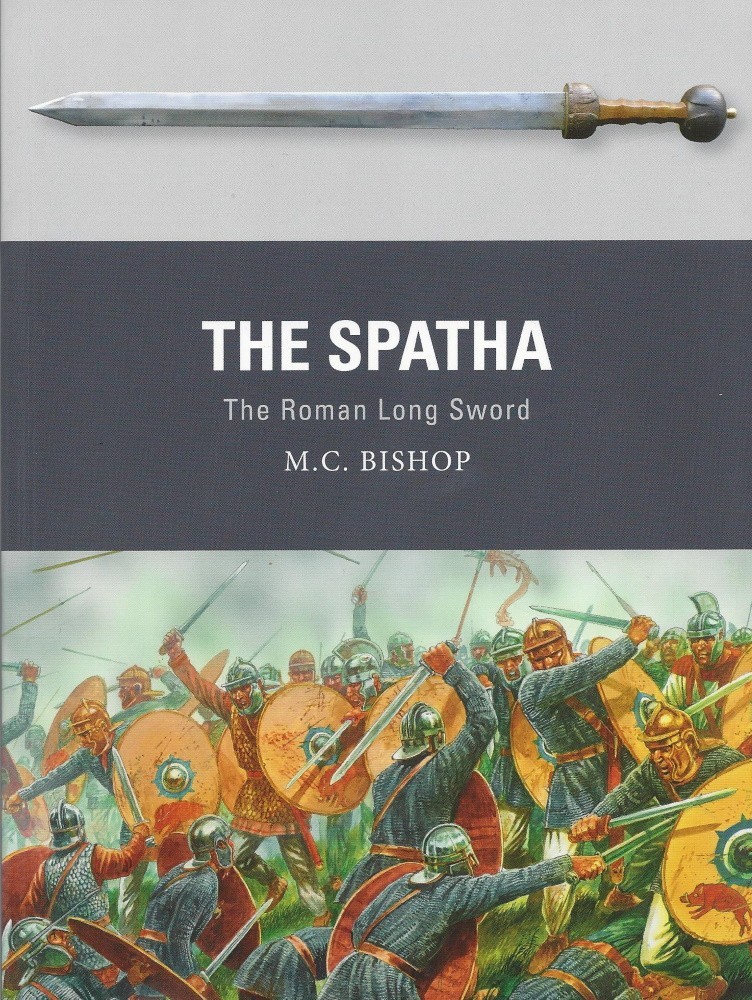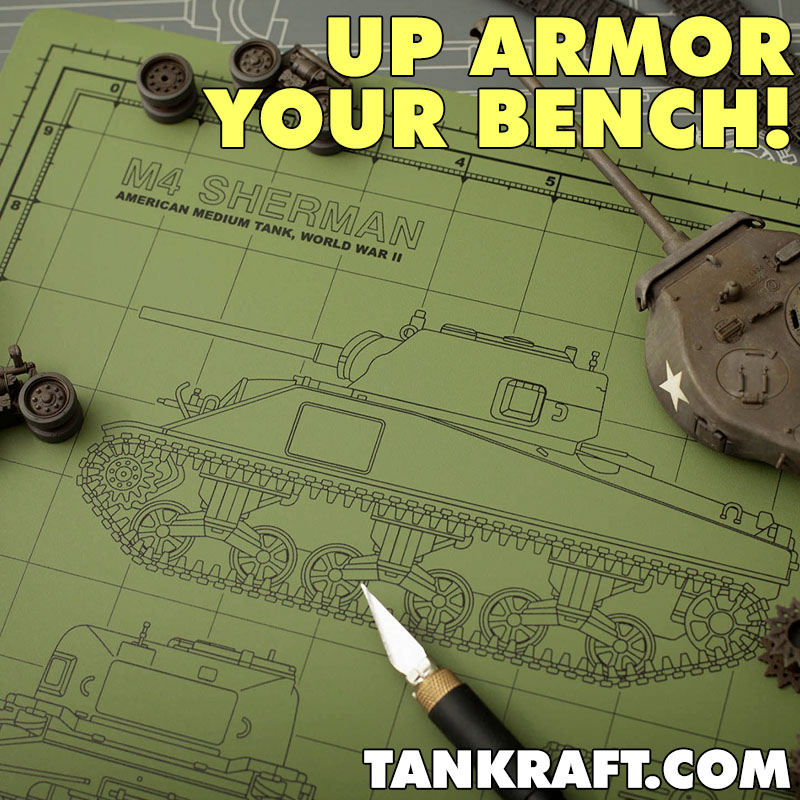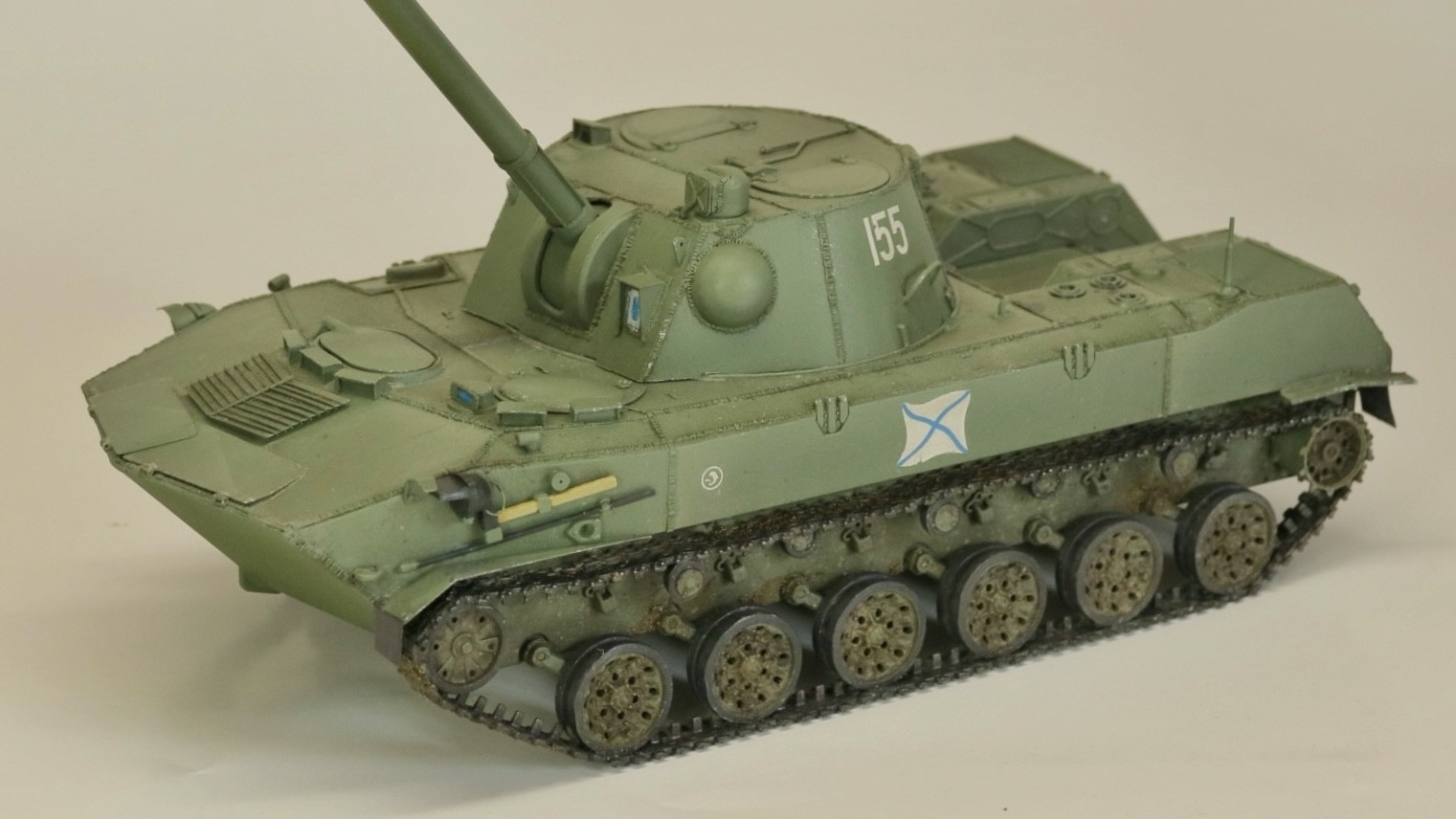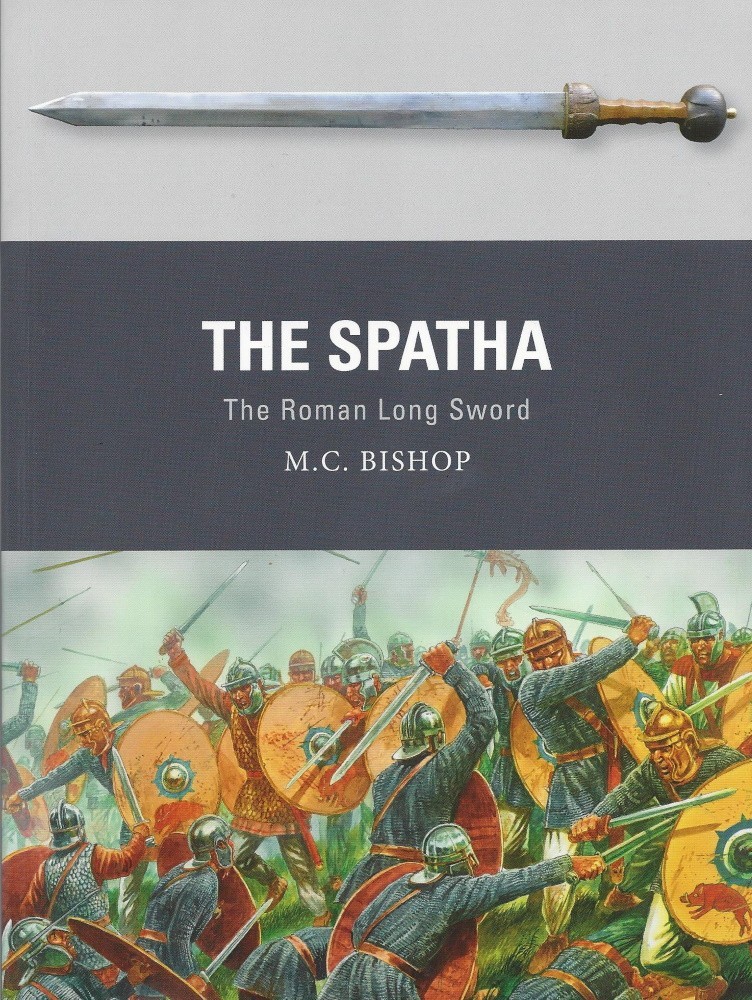
Introduction
The Spatha, The Roman Long Sword is a recent release from Osprey Publishing in the series Weapon, title number 72. Authored by M.C. Bishop and illustrated by Peter Dennis, the book is catalogued with the Osprey Short code WPN 72, and ISBN 9781472832399. Perhaps the iconic sword of antiquity, the spatha was the tool that won – and held - much of the Roman Empire.
Osprey introduces the book:
Adopted from the Celts in the 1st century BC, the spatha, a lethal and formidable chopping blade, became the primary sword of the Roman soldier in the Later Empire. Over the following centuries, the blade, its scabbard, and its system of carriage underwent a series of developments, until by the 3rd century AD it was the universal sidearm of both infantry and cavalry.
Thanks to its long reach, the spatha was the ideal cavalry weapon, replacing the long gladius hispaniensis in the later Republican period. As the manner in which Roman infantrymen fought evolved, styles of hand-to-hand combat changed so much that the gladius was superseded by the longer spatha during the 2nd century AD. Like the gladius, the spatha was technologically advanced, with a carefully controlled use of steel. Easy maintenance was key to its success and the spatha was designed to be easily repaired in the field where access to a forge may have been limited. It remained the main Roman sword into the Late Roman period and its influence survived into the Dark Ages with Byzantine, Carolingian and Viking blades.
Drawing together historical accounts, excavated artifacts and the results of the latest scientific analyses of the blades, renowned authority M.C. Bishop reveals the full history of the development, technology, training and use of the spatha: the sword that defended an empire.
We did not study weapons in my Roman civilization classes, so my ideas about Roman swords unfortunately came from Hollywood. Fortunately, Mr. Bishop has taken the time to share his knowledge and insight with us through this book. Let’s cut through the fiction for triumph of facts.
Content
The Spatha is 80 pages of information presented through five chapters, and supporting sections:
INTRODUCTION
DEVELOPMENTChanging function
USE
The cut and thrust
IMPACT
The sword that defended an empire
CONCLUSION
GLOSSARY
BIBLIOGRAPHY
INDEX
This book is a font of knowledge presented through a text very well supported with illustrations, many by the author. This is a complex book. Apparently, there is no single progenitor of the Spatha, and the many known and presumed ancestors of it are examined. This is one of those books where you need to suppress all distractions, get comfortable, and be ready to spend a good amount of time carefully reading.
Introduction focuses on the use of spatha and the meaning, as well as the Roman soldiers who wielded it. It presents a battle against a British chieftain, of which Cassius described the different weapons used by the legionnaires and the weapons used by the Roman auxiliaries. It also goes on to discuss how the spatha was made, including different metals, castings, and a form of welding. Chapter Development is broken up into several sub-sections. They examine a rather complex ancestry of the spatha, from Gallic and Celtic origins, through the Late Republican, the Early Principate and Later Principate eras, and beyond. It includes details of the manufacturer of the swords. I've never thought much about how swords were made other than casting iron or steel, then sharpening them, but this book shows that a Roman sword during a particular period was made of three different types of metal, welded together.
Chapter Use starts with Cut and Thrust, interpreting the evidence and then continues on to the cavalry spatha to AD 100. This chapter is illustrated with color battle scenes and continues on to examine the spatha in later epochs. An interesting sub-chapter presents the subject of ownership. A Roman soldier owned his sword. Whether it was obtained from private manufacturers, or issued by Rome with a deduction from pay, is uncertain. Proof of personal ownership is all but certain as of some 600 spatha that have been recovered, many of them have the inscriptions and names of the wielder.
Carriage is yet another sub-chapter recounting how the swords and other equipment were carried by horseman as well as the Infantry, as described by Josephus. Care and Maintenance, and Decoration and Display are two topics covered, as is Training. Interesting are the descriptions of methods of training to build up one's wrist, failure to do so could have dire consequences as recorded by Ammianus:
Martinez, alarmed by this threat, and seeing the imminent danger to his life, drew his sword and attacked Paulus. However, because his hand was weak, he was unable to wound him mortally and then plunged his drawn sword into his own side. Thus, with this unseemly type of death, a most just man died.
Into Battle presents how the sword was actually used, and how it was not, despite Hollywood depictions. This sub-chapter is illustrated with a battle scene. Distribution is the next sub-section and examines how widespread the swords were. This chapter ends with Conclusions, self-explanatory.
The next chapter, Impact, examines in sub-chapters and topics Using the Spatha, Psychological and Physical Impact, Words and Weapon Tree, Politics and the Spatha, Derivatives, and Modern Reconstructions. The final chapter Conclusions is self-explanatory and only partially fills one page. It postulates upon spatha versatility and how it equipped various military formations from auxiliary cavalry, to Legionnaire infantry, through to Saxon and Viking weapons. It sums up how the blades changed in size and scope, and reiterates forms of construction. Finally, the book includes a one-page glossary translating a few dozen words.
Artwork, Photographs, Graphics
Illustrations are black-and-white pen and ink drawings, detailed with shading, depicting single swords, such as Viking swords of the late 9th century, and families of swords. Likewise, the author also illustrates scabbard fittings, decorative inlays, figures and similar accoutrements. Artist Peter Dennis created several color illustrations for the book.
1. Two-page color battle scene: The Battle for Gelduba c.69 AD: auxiliary cavalry battling Batavian rebels.
2. Two-page color battle scene: The Retaking of Britannia by Constantius.
3. Illustration: leather baldric of the 2nd or 3rd century AD.
4. Color illustration: three spathae and their scabbards, accompanied by a call out requiring half the page to describe the six items.
5. Illustration: three types of metal and how they were melded together to construct the blade.
6. Illustration: five variants of the spatha long sword from around Europe.
7. Illustration: six swords, found all around Europe.
8. Illustration: 11 types of spatha blade cross sections.
9. Illustration: spatha, baldric and belt fittings from the Lyon burial; shows the artifacts as well as how they would have been mounted on the leather belt.
10. Illustration: spatha hilts - side, top, and face.
11. Illustration: five types of spatha from various places in Europe.
12. Illustration: two late swords from France of the type that Gallic auxiliary cavalry might have used 1st century BC, speculation of the origins of the spatha.
13. Illustration: leather baldric of the 1st or 3rd centuries found in Denmark; 12 items and views.
14. Illustration: inlaid figures in spatha blades.
15. Illustration: cavalry belt plates
16. Illustration: copper alloy castings from a scabbard
17. Illustration: examples of scabbard runners (12).
18. Illustration: baldric phalerae.
19. Illustration: seven examples of spatha hilt types from early Celtic, Early Imperial Roman, Later Imperial Roman, Dominate, Germanic, Saxon and Viking.
Photography
Reinforcing the text are dozens of color photos of swords, scabbards, and baldric phalerae (discs). Many are reproductions, but the majority of them are recovered original artifacts in various states of decay. These are from museums and personal collections. Some photos are not of sword sat all, i.e., an altar of a former legionary erected in Germany, bas-relief decorations, and statues. These are not just odd inclusions, they all display the subject of the Roman long sword, it's use, and its importance to the Roman military.
Table
Spatha sizes: a full-page listing two dozen swords from the Early Principate through the Dominate periods, the museum the samples belong to, and physical characteristics:
· Total length
· Blade length
· Blade width
· Tip length
· Thickness
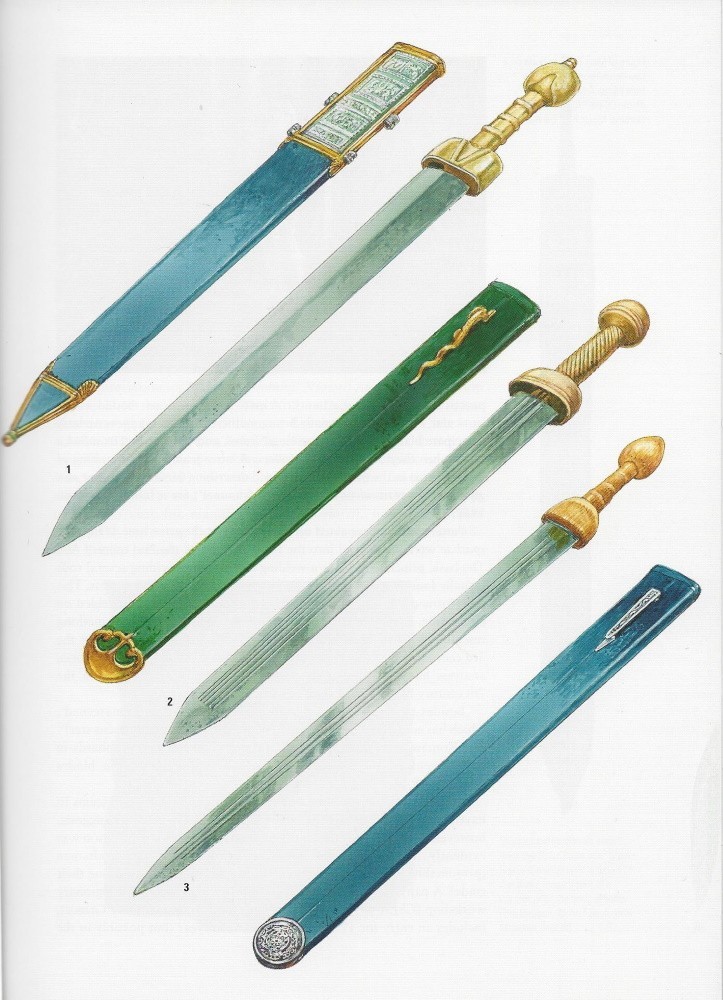

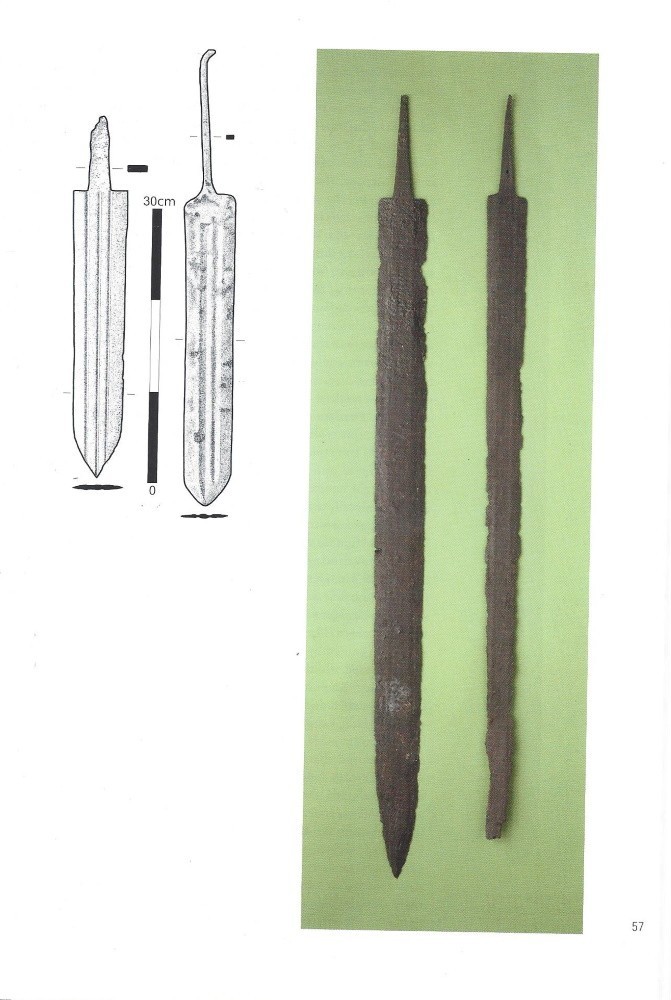
Conclusion
This very detailed in-depth book by a world-renowned expert is very eye-opening, and very satisfying. I'm amazed at the level of detail the author includes, visually supported with photographs and his drawings enhance the value of this book. Without them it would be difficult, I believe, to visualize just from the text everything that the author is attempting to teach us. I don't look for things to criticize in a review, but I realize nothing is perfect. Regardless, I cannot think of anything worth criticizing about this book. I believe that modelers and historians, artists and reenactors of the Roman era will find this book an excellent source for the swords that they display. Osprey publishes a number of books about Roman equipment, formations, battle tactics, standards, cavalry, and specific battles, e.g., two of the Roman titles in the Weapon series are The Gladius and ThePilum. I found this book to be educational, interesting and inspiring, and I think you will too. Recommended.











